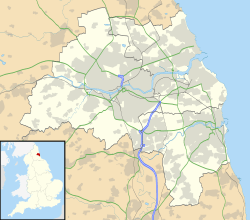GreyFriars, Newcastle-upon-Tyne facts for kids
| Monastery information | |
|---|---|
| Order | Order of Friars Minor |
| Established | 1237 |
| Disestablished | 1538 |
| Diocese | Diocese of York |
| Site | |
| Location | Newcastle-upon-Tyne, Northumberland, England, |
| Coordinates | 54°58′25″N 1°36′44″W / 54.9735743°N 1.6123509°W |
| Visible remains | None |
Greyfriars was an old religious building called a friary in Newcastle-upon-Tyne, England. It was started in 1237 on Pilgrim Street. After the King closed down many religious places, Greyfriars was sold. Later, a new house called New Place was built on its site. This house was later known as Anderson Place. Eventually, it was taken down to make way for Grey Street, a famous street in Newcastle.
Contents
Greyfriars: An Old Friary
The Greyfriars friary was built in 1237. It was located on Pilgrim Street in Newcastle-upon-Tyne. A friary is a place where friars, who are like monks, live and work. They dedicate their lives to God and helping others. The friary was sold after the Dissolution of the Monasteries. This was when King Henry VIII closed many monasteries and friaries in England.
New Place: A Grand Home
| New Place or Anderson Place |
|
|---|---|
| Type | Private Residence |
| Location | Newcastle-upon-Tyne |
| Built | 16th Century |
| Demolished | 1835 |
| Architectural style(s) |
|
After the friary was closed, a rich merchant named Robert Anderson bought the land. He built a large private house there. It was called "Newe House" at first. People said it was a "princely house" built from the old friary's stones.
In 1646, an important event happened here. King Charles I was held prisoner in New Place by the Scots. This was during the English Civil War.
Changes to the Mansion
Robert Anderson left his property to his relative, Sir Francis Anderson. In 1675, Sir Francis sold New Place to Sir William Blackett. Sir William added two big wings to the house, making it even larger.
The mansion stayed in the Blackett family for many years. It passed to Sir William's son, Sir William Blackett, 2nd Baronet. Then it went to his nephew, Sir Walter Calverley-Blackett. In 1782, Sir Walter's successor sold the house. It was bought by George Anderson, a wealthy builder. He divided the large house into three smaller homes.
Anderson Place: The Final Chapter
In 1801, George Anderson's son, Major George Anderson, moved into one of the homes. He changed the name of the property to Anderson Place. When he passed away in 1831, the houses went to his cousin, Thomas Anderson.
In 1834, Thomas Anderson sold Anderson Place for £50,000. The buyer was Richard Grainger, a famous Newcastle builder. Thomas Anderson and his family then moved to Little Harle Tower in Kirkwhelpington, Northumberland.
Anderson Place was torn down in 1835. This was a big part of Richard Grainger's plan to rebuild Newcastle. Demolishing the old mansion allowed for the creation of new buildings and the famous Grey Street.


